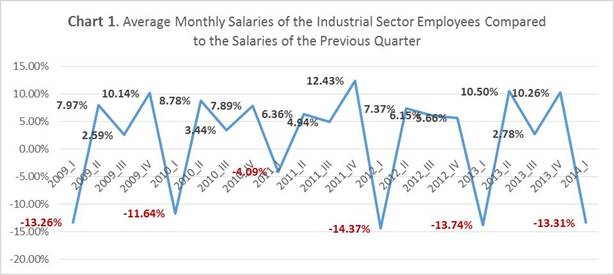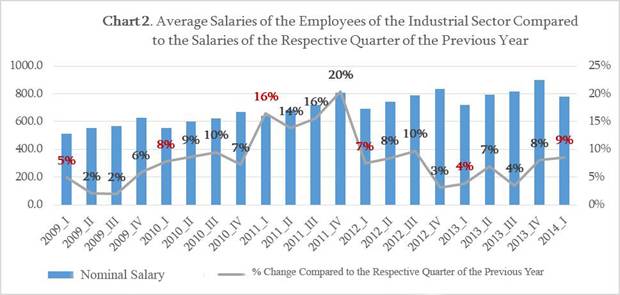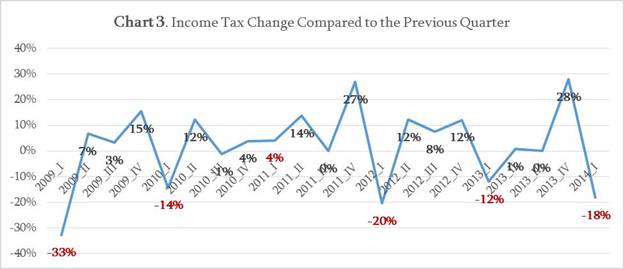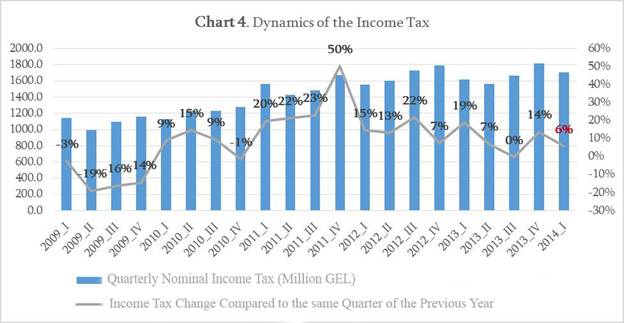According to the data published by the National Statistics Office of Georgia (GeoStat), the average monthly wages of people employed in the industrial sector have decreased by 13.33% in the 1st quarter of 2014 as compared to the last quarter of 2013. On 17 June 2014, Minister of Finance of Georgia, Nodar Khaduri, commented on the statistics published by GeoStat and said: “I’ll ask for the data in the Statistics Office and find out what it is based upon. Revenues from income tax have been increased and, as you know, income tax directly depends on the amount of wages. Hence, since the revenues have increased, the wages must have been increased as well. I promise I shall look into this matter.”
After he examined the issue, Nodar Khaduri made another statement: “These data have been misinterpreted. If you examine it closely, it is obvious that the wages at the end of each year are higher than at the beginning. This is due to the fact that wages are sometimes issued twice in December. Not only once. This happened in 2013, 2012 and other years as well. I would like to inform you that in the first quarter of this year, the average wages were increased by 10% as compared to the same period of the previous year. This information also comes from the National Statistics Office.”
FactCheck took interest in this statement.
According to the Tax Code of Georgia, the personal income tax payer is an individual (resident or non-resident) who, in a certain period of time, received income from a source base in the country. The personal income tax constitutes 20% of total income. According to current practice, the income tax of an industrial sector employee is paid by the employer. Accordingly, the changes (mainly reduction) in the average wages in this sector should influence the amount of taxes as well. That is the main logic in the statements of the Minister of Finance.
It should also be clarified that not only wages (or any other income received in the form of wage, for example, insurance) are subject to income taxation but other sorts of income as well (for example, rentals received by the individual). However, revenues from wage taxation constitute 90% of the revenues gathered by personal income tax and, consequently, wage changes have the biggest influence on the absolute amount of income tax.
While comparing the average quarterly wage rates one should take seasonality into account as well and there are several reasons for this. This factor is particularly important given the distinctive features of the agricultural and tourism sectors. These sectors constitute an important part of the Georgian economy and are strictly seasonal.
Another important factor in this case is the system of bonuses in the country. The yearly bonuses are mainly distributed in the last quarter of the year. Hence, it is quite logical that the average wages are higher at the end of the year than at the beginning. So, it is important to take seasonality into consideration and compare the quarterly average wages to the same period of the previous year and not to the other quarters of the same year.
Comparing the average monthly nominal wages of the 1st quarter of 2014 (GEL 779.1) with the same variable of the last quarter of 2013 (GEL 898.7) gives us a 13.33% reduction while comparing the average wages of the first quarter of 2014 to the wages of the same period of time in 2013 (GEL 717.7) gives 9% growth. The same is true for previous years as well (as in Charts 1 and 2).
 Chart 1 depicts the changes in the average monthly wages as compared to the previous quarter of the year, since 2009. From the chart it is clear that seasonality plays a big role in the changes of the wages. According to these data, a sharp decrease in wages as compared to the end of the previous year is characteristic for the 1st quarter of each year.
Chart 1 depicts the changes in the average monthly wages as compared to the previous quarter of the year, since 2009. From the chart it is clear that seasonality plays a big role in the changes of the wages. According to these data, a sharp decrease in wages as compared to the end of the previous year is characteristic for the 1st quarter of each year.
 Chart 2 shows the comparison of average monthly wages based upon the change of seasons. We can see the growth in every new quarter of the year. More accurately, Chart 2 shows 9% growth in the 1st quarter of 2014 and, supposedly, that is the number which the Minister used in his second statement.
In order to check the credibility of Khaduri’s statement, it would be interesting to see how the dynamics of personal income tax follow the trend discussed above.
Chart 2 shows the comparison of average monthly wages based upon the change of seasons. We can see the growth in every new quarter of the year. More accurately, Chart 2 shows 9% growth in the 1st quarter of 2014 and, supposedly, that is the number which the Minister used in his second statement.
In order to check the credibility of Khaduri’s statement, it would be interesting to see how the dynamics of personal income tax follow the trend discussed above.

 On the one hand, Chart 3 reflects the dynamics of income tax which is similar to the dynamics of average wages; namely, in the first quarter of every year (except 2011), we have a sharp reduction in the nominal indicator of the tax which constituted 18% in 2014, 12% in 2013 and 20% in 2012. On the other hand, in Chart 4 we can see that from 2011, taking seasonality into account, there is an increase of the nominal indicator of personal income tax in comparison to the same quarter of the previous year.
Thus, the statement of the Minister of Finance is rather logical. It should also be noted that there is a possibility of the average monthly wages and the personal income tax indicators moving in different directions. This would happen in the case of a sharp increase in employment in the lowest-paid sectors in the economy. In such a case the low-paid jobs would reduce the average monthly wage indicator while the nominal personal income tax indicator would grow. To check the possibility of such a case one must compare the statistics of quarterly employment to the growth of personal income tax and the average monthly wage. However, since we do not have such statistics we cannot look into this phenomenon.
Conclusion
The study revealed that the data published by GeoStat were misinterpreted without taking seasonality into account. The statistics of the average monthly wages in the industrial sector included the quarterly bonuses as well. The Georgian practice is to distribute the bonuses in the last quarter of the year and they are also subject to personal income taxation. Furthermore, the average monthly nominal wages and personal income tax statistics show similar trends.
The importance of seasonality in the agricultural and tourism sectors of the economy should also be noted.
In his first statement, Nodar Khaduri underscored the importance of these trends, taking the seasonality factor into account which includes the comparison of the quarterly data to the data of the same period of the previous year. This kind of comparison reflects the growth both in personal income tax and the average monthly wages. This trend verifies Khaduri’s statement.
Hence, FactCheck concludes that both statements of the Minister of Finance of Georgia are TRUE.
On the one hand, Chart 3 reflects the dynamics of income tax which is similar to the dynamics of average wages; namely, in the first quarter of every year (except 2011), we have a sharp reduction in the nominal indicator of the tax which constituted 18% in 2014, 12% in 2013 and 20% in 2012. On the other hand, in Chart 4 we can see that from 2011, taking seasonality into account, there is an increase of the nominal indicator of personal income tax in comparison to the same quarter of the previous year.
Thus, the statement of the Minister of Finance is rather logical. It should also be noted that there is a possibility of the average monthly wages and the personal income tax indicators moving in different directions. This would happen in the case of a sharp increase in employment in the lowest-paid sectors in the economy. In such a case the low-paid jobs would reduce the average monthly wage indicator while the nominal personal income tax indicator would grow. To check the possibility of such a case one must compare the statistics of quarterly employment to the growth of personal income tax and the average monthly wage. However, since we do not have such statistics we cannot look into this phenomenon.
Conclusion
The study revealed that the data published by GeoStat were misinterpreted without taking seasonality into account. The statistics of the average monthly wages in the industrial sector included the quarterly bonuses as well. The Georgian practice is to distribute the bonuses in the last quarter of the year and they are also subject to personal income taxation. Furthermore, the average monthly nominal wages and personal income tax statistics show similar trends.
The importance of seasonality in the agricultural and tourism sectors of the economy should also be noted.
In his first statement, Nodar Khaduri underscored the importance of these trends, taking the seasonality factor into account which includes the comparison of the quarterly data to the data of the same period of the previous year. This kind of comparison reflects the growth both in personal income tax and the average monthly wages. This trend verifies Khaduri’s statement.
Hence, FactCheck concludes that both statements of the Minister of Finance of Georgia are TRUE.
 Chart 1 depicts the changes in the average monthly wages as compared to the previous quarter of the year, since 2009. From the chart it is clear that seasonality plays a big role in the changes of the wages. According to these data, a sharp decrease in wages as compared to the end of the previous year is characteristic for the 1st quarter of each year.
Chart 1 depicts the changes in the average monthly wages as compared to the previous quarter of the year, since 2009. From the chart it is clear that seasonality plays a big role in the changes of the wages. According to these data, a sharp decrease in wages as compared to the end of the previous year is characteristic for the 1st quarter of each year.
 Chart 2 shows the comparison of average monthly wages based upon the change of seasons. We can see the growth in every new quarter of the year. More accurately, Chart 2 shows 9% growth in the 1st quarter of 2014 and, supposedly, that is the number which the Minister used in his second statement.
In order to check the credibility of Khaduri’s statement, it would be interesting to see how the dynamics of personal income tax follow the trend discussed above.
Chart 2 shows the comparison of average monthly wages based upon the change of seasons. We can see the growth in every new quarter of the year. More accurately, Chart 2 shows 9% growth in the 1st quarter of 2014 and, supposedly, that is the number which the Minister used in his second statement.
In order to check the credibility of Khaduri’s statement, it would be interesting to see how the dynamics of personal income tax follow the trend discussed above.

 On the one hand, Chart 3 reflects the dynamics of income tax which is similar to the dynamics of average wages; namely, in the first quarter of every year (except 2011), we have a sharp reduction in the nominal indicator of the tax which constituted 18% in 2014, 12% in 2013 and 20% in 2012. On the other hand, in Chart 4 we can see that from 2011, taking seasonality into account, there is an increase of the nominal indicator of personal income tax in comparison to the same quarter of the previous year.
Thus, the statement of the Minister of Finance is rather logical. It should also be noted that there is a possibility of the average monthly wages and the personal income tax indicators moving in different directions. This would happen in the case of a sharp increase in employment in the lowest-paid sectors in the economy. In such a case the low-paid jobs would reduce the average monthly wage indicator while the nominal personal income tax indicator would grow. To check the possibility of such a case one must compare the statistics of quarterly employment to the growth of personal income tax and the average monthly wage. However, since we do not have such statistics we cannot look into this phenomenon.
Conclusion
The study revealed that the data published by GeoStat were misinterpreted without taking seasonality into account. The statistics of the average monthly wages in the industrial sector included the quarterly bonuses as well. The Georgian practice is to distribute the bonuses in the last quarter of the year and they are also subject to personal income taxation. Furthermore, the average monthly nominal wages and personal income tax statistics show similar trends.
The importance of seasonality in the agricultural and tourism sectors of the economy should also be noted.
In his first statement, Nodar Khaduri underscored the importance of these trends, taking the seasonality factor into account which includes the comparison of the quarterly data to the data of the same period of the previous year. This kind of comparison reflects the growth both in personal income tax and the average monthly wages. This trend verifies Khaduri’s statement.
Hence, FactCheck concludes that both statements of the Minister of Finance of Georgia are TRUE.
On the one hand, Chart 3 reflects the dynamics of income tax which is similar to the dynamics of average wages; namely, in the first quarter of every year (except 2011), we have a sharp reduction in the nominal indicator of the tax which constituted 18% in 2014, 12% in 2013 and 20% in 2012. On the other hand, in Chart 4 we can see that from 2011, taking seasonality into account, there is an increase of the nominal indicator of personal income tax in comparison to the same quarter of the previous year.
Thus, the statement of the Minister of Finance is rather logical. It should also be noted that there is a possibility of the average monthly wages and the personal income tax indicators moving in different directions. This would happen in the case of a sharp increase in employment in the lowest-paid sectors in the economy. In such a case the low-paid jobs would reduce the average monthly wage indicator while the nominal personal income tax indicator would grow. To check the possibility of such a case one must compare the statistics of quarterly employment to the growth of personal income tax and the average monthly wage. However, since we do not have such statistics we cannot look into this phenomenon.
Conclusion
The study revealed that the data published by GeoStat were misinterpreted without taking seasonality into account. The statistics of the average monthly wages in the industrial sector included the quarterly bonuses as well. The Georgian practice is to distribute the bonuses in the last quarter of the year and they are also subject to personal income taxation. Furthermore, the average monthly nominal wages and personal income tax statistics show similar trends.
The importance of seasonality in the agricultural and tourism sectors of the economy should also be noted.
In his first statement, Nodar Khaduri underscored the importance of these trends, taking the seasonality factor into account which includes the comparison of the quarterly data to the data of the same period of the previous year. This kind of comparison reflects the growth both in personal income tax and the average monthly wages. This trend verifies Khaduri’s statement.
Hence, FactCheck concludes that both statements of the Minister of Finance of Georgia are TRUE.








